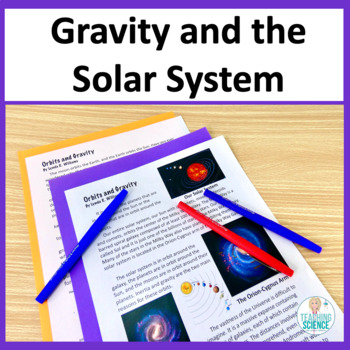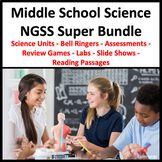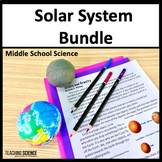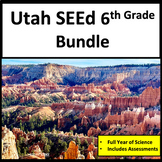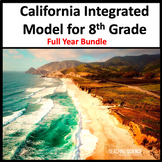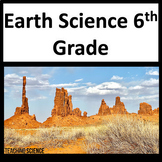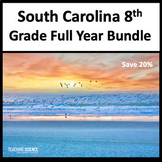Gravity and the Solar System and Motions Within Galaxies MS ESS1-2
- PDF
What educators are saying
Also included in
- Do you teach 6th-grade science in Indiana? This is a full-year bundle for the Indiana Science Standards for 6th grade. This bundle covers all the 6th-grade standards and gives your science activities for the year! Aligns with 2023 Indiana Academic Science Standards. Benefits of this Bundle:phenomenaPrice $104.76Original Price $130.95Save $26.19
- This NGSS Middle School Science Bundle is my biggest bundle! It includes all my middle school science units, Bell Ringers, Jeopardy-style games, Assessments, and Informational Text Science Units for Middle School. It addresses all the NGSS standards for 6th, 7th, and 8th Grade NGSS science. Save whePrice $489.55Original Price $699.35Save $209.80
- This bundle for Earth and Space Science Utah SEEd 6.1 Strand. Students will develop models of the Earth-Sun-Moon system, explain gravity in galaxies, and determine the scale and properties of objects in the solar system. Save 20% by purchasing together! Utah SEEd 6.1.1Develop and use a model of thePrice $24.80Original Price $25.50Save $0.70
- Do you need to teach about the solar system and Sun, Moon, and Earth? This Earth and Space NGSS bundle covers all Middle School Earth’s Place in the Universe standards. Students will develop models of the Earth-Sun-Moon system, explain gravity in galaxies, and determine the scale and properties of oPrice $30.00Original Price $37.50Save $7.50
- This Bundle for Utah SEEd 6th grade includes science resources for each strand and standard. Each unit included addresses a Utah SEEd standard for 6th grade. Students will love these engaging activities for Utah SEEd 6th Grade. You will love saving time by having someone creating resources who reallPrice $117.56Original Price $146.95Save $29.39
- Do you want to save time in planning for middle school science? This Middle School Science Curriculum Bundle addresses all the DCIs for Middle School NGSS. Complete units with phenomena-based 5E Science Lessons for 6th, 7th, and 8th Grade.Save more than 30% by purchasing this bundle! ❤️ Get back toPrice $304.32Original Price $434.75Save $130.43
- This is a bundle for 8th Grade: NGSS California Integrated Model. This bundle covers the PEs and standards for NGSS for 8th grade in California. Purchase of this 8th-grade science bundle will save you 20% on these resources. If you teach 8th grade science in California, you need this bundle!ResourcePrice $146.56Original Price $183.20Save $36.64
- This is a full-year earth and space science curriculum bundle. If you teach middle school earth science, you need this bundle! It is perfect for schools where 6th-grade science addresses all the Earth and Space Science standards. This bundle will save you 20% and cover all the Earth Science StandardPrice $132.04Original Price $165.05Save $33.01
- Do you teach 8th Grade Science in South Carolina? This science bundle is just what you need. This South Carolina eighth-grade bundle covers all the science standards for SC Ready 8th grade. It is a full-year bundle, and you save 20% on these resources by purchasing in the bundle! From the South CaroPrice $107.20Original Price $134.65Save $27.45
- Do you teach 6th-grade science in Kentucky? You need this science bundle! This Kentucky 6th-grade curriculum covers all the standards for Kentucky sixth-grade science. It is a full year of science lessons, and you save 20% on these resources by purchasing them in the bundle! Over 800 pages and sliPrice $107.20Original Price $134.90Save $27.70
Description
Do you need to teach about Gravity in the Solar System? Students will love these activities on gravity in the solar system. Students will make a model to describe the role of gravity in the motions within galaxies and in the solar system. Gravity and Inertia work together to keep the Earth in orbit around the Sun and the moons in orbit around their planets.
Benefits of this Gravity and Inertia Unit:
- Standards-aligned
- engaging activities
- Easy to use
This Unit Includes:
- three pages of reading passages
- comprehension questions
- lab and lab directions
- lab write-ups
- demonstration
- lesson plans
- response sheets
- Interactive notebook flaps
- QR code research
- quiz
- answer keys
Teachers Love This Resource!
Michelle ⭐️ ⭐️ ⭐️ ⭐️ ⭐️ Extremely Satisfied
I LOVE THIS RESOURCE. My students and I found this assignment very useful. When completed, it served as a great study guide.
This resource is aligned with NGSS MS ESS1-2
Develop and use a model to describe the role of gravity in the motions within galaxies and the solar system.
From the Earth’s Place in the Universe in the Next Generation Science Standards
NGSS MS ESS1-2
Develop and use a model to describe the role of gravity in the motions within galaxies and the solar system.
Utah SEEd 6.1.2 Develop and use a model to describe the role of gravity and inertia in the orbital motions of objects in our solar system. This is part of the Structure and Motion within the Solar System.
The nonfiction passages also align with the Reading Informational Text Standards for CCSS.
Students will be able to define gravity and inertia and learn a little about the scientists who contributed to these ideas.
Science Concepts Taught in this Unit:
- Gravity
- Gravity in space
- Objects in motion stay in motion unless a force acts upon them
- Objects at rest stay at rest unless a force acts upon them
- Objects with large masses in space bend the fabric of space- we experience this as gravity
- The greater the mass of an object, the greater the gravitational pull
- The greater the distance between objects the less the gravitational pull
- Size and distance in the universe
- Research on Planets and other Celestial Bodies in Solar System
- Milky Way Galaxy
Save 20% by purchasing in a bundle: Earth's Place in the Universe
Created by Lynda R. Williams
Teaching Science With Lynda
Science and Engineering Practices Used By Students
- Asking questions or defining problems
- Developing and using models
- Planning and carrying out investigations
- Analyzing and interpreting data
- Constructing explanations and designing solutions
- Engaging in argument from evidence
Would you like more information on teaching Gravity and Inertia in Space?
These resources are created by Lynda R. Williams at Teaching Science
Follow me and get news of my new resources. Each new resource is discounted by 50% for the first 24 hours!
See the preview for more details!
See more of my resource from NGSS
Earth, Moon and Sun System: Developing Models NGSS MS ESS1-1
Weather and Climate Complete Middle School Bundle
Middle School Ecosystem NGSS Bundle
* My resources are secure and not editable for copyright reasons.

